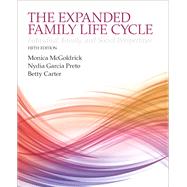NOTE: Used books, rentals, and purchases made outside of Pearson
If purchasing or renting from companies other than Pearson, the access codes for the Enhanced Pearson eText may not be included, may be incorrect, or may be previously redeemed. Check with the seller before completing your purchase.
This package includes the Enhanced Pearson eText and the bound book.
Updated, expanded, and more comprehensive than ever, this new Fifth Edition a classic family therapy resource, The Expanded Family Life Cycle, gives readers a solid understanding of human development and the life cycle. Featured are a groundbreaking integration of individual development within a systemic context discussion of the increasing racial, ethnic, and cultural diversity across the life cycle in the United States today; life cycle perspectives on LGBT issues, alcohol, sexuality, migration, social class, violence in the family, and assessment of “home place” as fundamental to clinical work. This edition moves from society’s general orientation of nuclear families to consider a more diverse and inclusive definition of society’s rapidly changing family patterns, one that considers, among other things, that the life cycle time frame itself has been expanding as people live longer and the patterns of coupling and child rearing continue to change. Also explored are the impact of issues at multiple levels of the human system and the individual, family households, extended family, community, cultural group, and the larger society. Included are new chapters on sexuality over the life curse, mental health as well as physical health in life cycle perspective, and friendship through the life cycle. The Enhanced Pearson eText features embedded self-check assessments.
Improve mastery and retention with the Enhanced Pearson eText*
The Enhanced Pearson eText provides a rich, interactive learning environment designed to improve student mastery of content. The Enhanced Pearson eText is:
- Engaging. The new interactive, multimedia learning features were developed by the authors and other subject-matter experts to deepen and enrich the learning experience.
- Convenient. Enjoy instant online access from your computer or download the Pearson eText App to read on or offline on your iPad® and Android® tablet.*
- Affordable. The Enhanced Pearson eText may be purchased stand-alone or with a loose-leaf version of the text for 40-65% less than a print bound book.
*The Enhanced eText features are only available in the Pearson eText format. They are not available in third-party eTexts or downloads.
*The Pearson eText App is available on Google Play and in the App Store. It requires Android OS 3.1-4, a 7” or 10” tablet, or iPad iOS 5.0 or later.
0134057279 / 9780134057279 Expanded Family Life Cycle, The: Individual, Family, and Social Perspectives with Enhanced Pearson eText -- Access Card Package
Package consists of:
- 0134056698 / 9780134056692 Expanded Family Life Cycle, The: Individual, Family, and Social Perspectives, Enhanced Pearson eText -- Access Card
- 0205968066 / 9780205968060 Expanded Family Life Cycle, The: Individual, Family, and Social Perspectives









